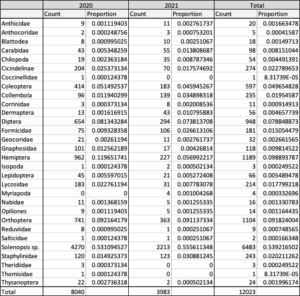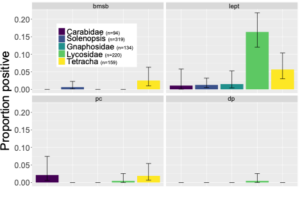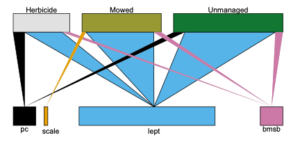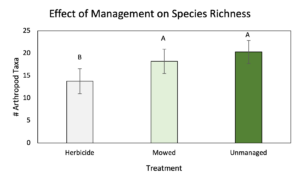Final report for GS20-233
Project Information
Brown marmorated stink bug (BMSB) (Halyomorpha halys) is an invasive stink bug that causes damage to multiple fruit and vegetable commodities across the world, including peaches. In addition to this invasive pest, peach growers in the Southeastern US must contend with a variety of other established insect pests. Currently, there are few integrated pest management tactics available for managing insect pests in peach production. However, there is increasing research evaluating the use of insect natural enemies to biologically suppress pests, but many of those projects focus on parasitic wasps and/or predators of eggs. In Chinese peach production, one cultural control tactic for managing insect pests is to manipulate the plants grown in the ground cover between the peach trees. With several of the insect pests of peaches in the Southeastern US, including BMSB, potentially spending part of their life cycle on the ground, we were interested in testing whether ground cover management can impact the insect predator community within peach orchards and subsequently the diet of these predators. As such, we used a combination of pitfall traps and molecular gut content analysis to identify ground-dwelling predators of common peach pests and we evaluated how ground typical cover management practices used in the Southeastern US can impact natural enemies and their diet.
- To identify the predators of BMSB that are present in Georgia peach orchards.
- To understand how existing ground cover management practices in Southeastern peach production impact communities of predators and their predation of BMSB.
Research
- To identify the predators of BMSB that are present in Georgia peach orchards.
To investigate the ground dwelling arthropod communities of Georgia peach orchards, we established experimental plots in the row middles of a peach orchard at the University of Georgia Horticulture Research Farm in Watkinsville, GA during the 2020 and 2021 growing seasons. Plots measured approximately 1.37 by 2.74 meters and contained a variety of naturally occurring grasses and small flowering weeds. To collect arthropods for molecular gut content analysis, we used dry pitfall traps constructed from two 32-ounce plastic deli cups, consisting of an outer sleeve with the bottom of the cup cut off and an inner cup with the lip cut off. The inner cup was filled with clear glass marbles covered with steel wire mesh to help segregate insects to mitigate intraguild predation. Four dry pitfall traps were placed approximately 1.2 meters from the center of each plot for a 24-hr period during three sampling periods throughout the 2020 and 2021 growing seasons: June, July, and August. Arthropods were collected from traps and placed into individual vials of approximately 99% pure ethanol. These samples were stored in the lab at approximately -20˚C to prevent the degradation of prey DNA before the samples were evaluated using molecular gut content analysis.
For our analysis, we chose the 5 most abundant groups of predators found in our dry pitfall traps, which consisted of fire ants (Solenopsis sp.), wolf spiders (Lycosidae), tiger beetles (Carabidae: Cicindelinae), ground spiders (Gnaphosidae), and other ground beetles (Carabidae). Molecular gut content analysis was performed using recommended best practices (King et al. 2008). Predators were rinsed using a 10% bleach solution, deionized water, and 99% pure ethanol to reduce environmental contamination before being transferred to microcentrifuge tubes for DNA extraction. We extracted DNA using QIAGEN DNeasy Blood and Tissue kit, following standard procedure for animal tissue extraction. Each plate consisted of 96 wells, including one negative control and one positive control. Plates containing extracted DNA were sealed and stored at -20˚C prior to use for PCR.
Predator gut contents were analyzed for DNA from four key peach pests: BMSB (Halyomopha halys Stål), plum cuculio (Conotrachelus nenuphar Herbst), San Jose scale (Comstockaspis perniciosus Comstock), and general Lepidoptera. We identified any detection of prey DNA above 0.075 RFUs as an instance of predation and used these data for further investigation into the effects of ground cover management on predation.
- To understand how existing ground cover management practices in Southeastern peach production impact communities of predators and their predation of BMSB.
In order to evaluate the impact of ground cover, the orchard plots from Objective 1 were managed in one of the three different ways: regularly mowed (“Mowed”), bare ground using a combination of broad spectrum herbicide and hand weeding (“Herbicide”), or allowed to grow freely with no intervention (“Unmanaged”). We originally had a fourth treatment where we planted a native, warm-season grass, nimblewill, but unfortunately the grass failed to establish in our plots. The other three treatments were chosen to imitate common ground cover management practices in commercial peach orchards in the Southeastern United States. Additionally, experimental plots were separated by similarly sized buffer plots, which were managed in the same way as the Mowed experimental plots. Mowing was performed 1 to 3 days prior to sampling, and herbicides were applied at the beginning of the growing season and reapplied as needed. All experimental plots were replicated 4 times using a Completely Randomized Block Design.
Similar to Objective 1 collection techniques, to collect arthropods for community composition, we used wet pitfall traps constructed from two 32-ounce plastic deli cups, consisting of an outer sleeve with the bottom of the cup cut off and an inner cup with the lip cut off and contained a 10% soap water solution to prevent the escape of captured arthropods and a clump of salt for preservation. Pitfall traps were placed approximately 1.2 meters from the center of each plot and covered by a paper plate or aluminum pie tray staked 2 to 5 cm off the ground to protect the traps’ contents. The traps were deployed for one week during each of three sampling periods throughout the 2020 and 2021 growing seasons: June, July, and August. Arthropods collected from these traps were stored together in vials containing 70% ethanol and kept at room temperature. All predaceous arthropods were identified to at least family level.
Statistical analysis:
To visualize the community composition of our experimental orchard, we compiled the total number of arthropods from each taxonomic group and their proportion within the community into a data table based on data collected from our wet pitfall traps. Then, to understand the effects of ground cover management and time on arthropod species richness, we constructed a mixed effects model in R Studio using ground cover treatment as our independent variables, the number of taxa as the response variable, and year as a random variable. We then selected the 5 most abundant predator and prey taxa from our data set and constructed additional mixed effects models using ground cover treatment as our independent variabls, the number of arthropods from a taxon we collected as the response variable, and year as a random variable. We then performed an ANOVA on each of these models to test for effects of ground cover treatment and time on species richness and abundance, followed by a Tukey’s HSD test using the “emmeans” command in R if a significant effect was detected. Based on the results of our molecular gut content analysis, we visualized the proportion of predators testing positive for each of our prey taxa. We then constructed a bipartite food web linking the frequency of predation to ground cover management and performed a PERMANOVA in R Studio to determine if ground cover management had a significant effect on predation.
In total, 30 arthropod taxa were identified from collections in Georgia peach orchards (Table 1). The 5 most abundant predator taxa were fire ants (Solenopsis sp.; n=6483), tiger beetles (Cicindelinae; n=274), wolf spiders (Lycosidae; n=214), ground spiders (Gnaphosidae; n=118), and ground beetles (Carabidae; n=98). We found that the majority of arthropods preferred more complex habitat provided by mowed or unmanaged ground cover as indicated by greater arthropod abundance as well as greater species richness and evenness. However, we also found that tiger beetles generally preferred less complex habitat resulting from removal of ground cover by herbicides. These results are mostly consistent with previous work that has associated complex habitat with enhanced arthropod communities, but also highlight that this association does not hold true for all beneficial insects, which may have important implications for conservation biocontrol and integrated pest management.
Through our PCR-assisted molecular gut content analysis, we were able to identify several common generalist predators that feed on common peach pests and habitat conditions in peach orchards that may promote biocontrol. Of the 940 predators we tested for prey DNA, we only received 65 positive reads, the majority of which were for Lepidoptera (moths or butterflies). Of the predators testing positive for Lepidoptera, the dominant group was wolf spiders (n=36), followed by tiger beetles (n=9). Additionally, Lepidoptera were the only prey for which ground spiders tested positive (n=2). Tiger beetles tested positive for both plum curculio (n=3) and BMSB (n=4). Plum curculio DNA was also found in the gut contents of ground beetles (n=2) and wolf spiders (n=1), and BMSB DNA was found in the gut contents of fire ants (n=2) (Figure 1). Unfortunately, we cannot determine from these data whether any of the Lepidopteran DNA were from key peach pests such as peachtree borer (Synanthedon exitiosa (Say)) or oriental fruit moth (Grapholita molesta (Busck)), but it is encouraging that common natural enemies are feeding on this important insect order.
Management had a marginal effect on the proportion of predators testing positive for prey DNA (Permanova, F2,35=2.95, P=0.054; Figure 2). Additionally, we found that the incidence of predation was marginally higher in the Unmanaged and Mowed plots (F2,35=2.95, P=0.054) compared to Herbicide plots. Comparison of predator communities revealed a significant difference between Herbicide plots and Unmanaged or Mowed plots (F2,9=3.51, P=0.011). However, fire ants and ground beetles were seemingly unaffected by treatment. Overall, though, bare ground in the Herbicide plots resulted in a significant decrease in species richness (Figure 3), as well as a decline in abundance of most of our common arthropod taxa.




Educational & Outreach Activities
Participation Summary:
Results from this project have been discussed with Georgia peach producers at several two Extension meetings organized by UGA Extension throughout the duration of this project. In addition, Daniel O’Connell has presented the results at two academic conferences. The references for those meetings are below. Finally, we have developed a fact sheet that provides an overview of common predaceous arthropods found in Georgia peach orchards. This fact sheet is expected to be published through University of Georgia’s Extension.
Daniel O’Connell, Jason Schmidt, and Brett R. Blaauw. 2022. Ground-dwelling predators in Georgia peaches and their responses to ground cover management. Entomological Society of America – Southeastern Branch Annual Meeting. San Juan, Puerto Rico.
Daniel O'Connell, Jason Schmidt, and Brett R. Blaauw. 2022. Predators, prey, and peaches: Using molecular gut content analysis to untangle the food web of the Southeastern peach agroecosystem. ESA, ESC, and ESBC Joint Annual Meeting. Vancouver, British Columbia, Canada.
Project Outcomes
Peaches grown in the Southeastern US are prone to numerous threats which adversely affect plant health and marketable yield, including pressure from diseases and pests. Key pests of peaches include plum curculio, San Jose scale, peachtree borer, lesser peachtree borer, and stink bugs (including BMSB). Damage caused by these pests can lead to reduced yield by directly effecting plant health, by causing developing fruit to drop prematurely, or by causing damage to fruits that renders them unmarketable. Currently, these pests are primarily managed in through applications of broad-spectrum insecticides such neonicotinoids, pyrethroids, and carbamates, which are known to have adverse effects on beneficial insects, the environment and wildlife. To mitigate the harmful side effects of pesticide use, integrated pest management programs are being developed for many crops, including peaches. One potential management tactic is conservation biological control, which seeks to support beneficial insect in order to naturally enhance pest suppression. Unfortunately, little is known about the natural enemy communities within Southeastern peach orchards or whether biological control is achievable. As such, this project described the community of ground-dwelling arthropods in Southeastern peach orchards, their response to three forms of ground cover management, and determined which groups are potential predators of common peach pests. We found that ground covers that consisted of mowed or unmanaged grasses and weeds were usually best at sustaining a diverse community of arthropods and promoting biocontrol, but this did not hold true for all major predators. As only a part of the larger picture of peach arthropod communities, our results are inconclusive but suggest that complex ground cover is more beneficial for arthropod conservation overall, which should ultimately increase the sustainability of Southeastern peach production.
Through our project, we made several discoveries that we believe will form a basis for future research regarding biological pest control, insect conservation, and agroecology. We identified and described a subset of the arthropod community in Southeastern peach orchards, analyzed their responses to ground cover management, identified important predator-prey interactions, and investigated in greater detail how a common peach predator interacts with a common peach pest. The information gathered by this research provides a starting point for peach growers seeking to implement conservation biocontrol into their cropping system and for ecologists interested in the peach agroecosystem. However, it is important to emphasize that the results of this study only form a small piece of the peach agroecology puzzle. We were not able to identify all our arthropod taxa beyond family or even order level or were we able perform PCR analysis for minor pests or other alternative prey such as aphids and other Hemiptera, springtails, or thrips. To gain a complete understanding of beneficial insect communities and conservation biological control in peaches, additional work will be needed to identify peach canopy arthropod communities, evaluate their responses to ground cover and other habitat characteristics, and identify their diets, as well as identify the ground dwelling community and their diets in more detail.
Bare ground in an orchard setting may be appealing in a weed competition standpoint, but previous research has shown that having plants growing within the orchard row middles can help in various ways, including water and soil retention. While additional work is needed to identify the most effective ground cover or cover crop to plant within an orchard, the results from this project demonstrate that having plants within the row middles can increase the insect species diversity which may ultimately help naturally suppress pest populations.